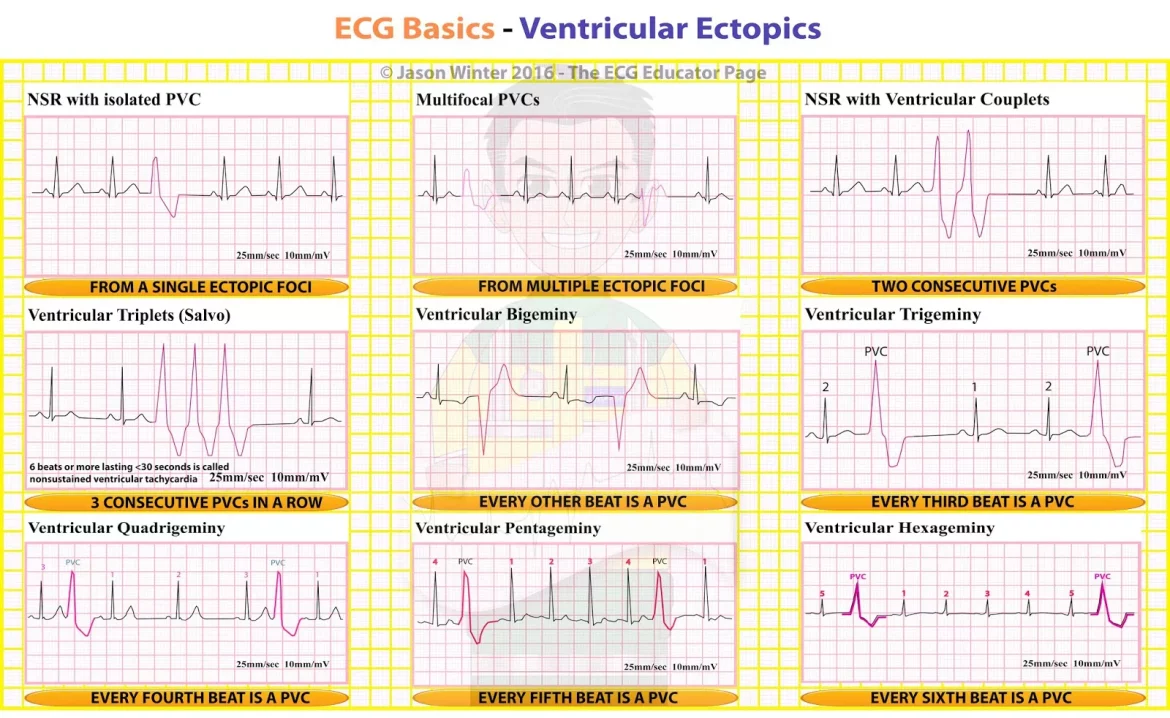Ventricular arrhythmia is a type of heart rhythm disorder originating from the ventricles, the lower chambers of the heart.
These arrhythmias occur when the electrical impulses that regulate the heartbeats become erratic, causing the ventricles to beat too quickly (tachycardia) or irregularly. This condition can significantly impact the heart’s ability to pump blood effectively, leading to various health complications.
Types of Ventricular Arrhythmia
There are several types of ventricular arrhythmias, each with different levels of severity and associated risks:
Ventricular Tachycardia (VT): This condition involves a rapid heart rate originating from the ventricles. VT can be sustained (lasting longer than 30 seconds) or non-sustained (lasting less than 30 seconds). Sustained VT can be life-threatening and may require immediate medical intervention.
Ventricular Fibrillation (VF): VF is a severe and life-threatening arrhythmia where the ventricles quiver instead of contracting properly, leading to a significant drop in blood pressure and cessation of blood flow to vital organs. Immediate treatment is essential to prevent sudden cardiac arrest and death.
Premature Ventricular Contractions (PVCs): These are extra, abnormal heartbeats originating in the ventricles. While PVCs are common and usually harmless, frequent PVCs or those occurring in a person with underlying heart disease can be problematic.
Causes of Ventricular Arrhythmia
Ventricular arrhythmias can result from various factors, including:
Coronary Artery Disease: Blockages in the coronary arteries can reduce blood flow to the heart muscle, leading to arrhythmias.
Heart Attack: Damage to the heart muscle from a heart attack can disrupt the electrical pathways.
Cardiomyopathy: Disease of the heart muscle can alter its structure and function, leading to arrhythmias.
Electrolyte Imbalances: Abnormal levels of electrolytes, such as potassium, magnesium, and calcium, can affect heart rhythm.
Congenital Heart Disease: Structural heart defects present from birth can predispose individuals to arrhythmias.
Drug Abuse: Stimulants like cocaine and methamphetamine can trigger ventricular arrhythmias.
Medications: Certain medications, particularly those that affect the heart’s electrical activity, can induce arrhythmias.
Symptoms And Diagnosis
The symptoms of ventricular arrhythmia can vary depending on the type and severity. Common symptoms include:
- Palpitations or a feeling of the heart racing
- Dizziness or lightheadedness
- Shortness of breath
- Chest pain or discomfort
- Fainting or near-fainting episodes
In severe cases, such as ventricular fibrillation, the individual may collapse suddenly and lose consciousness, indicating a medical emergency requiring immediate attention.
Diagnosing ventricular arrhythmia typically involves several tests and procedures:
Electrocardiogram (ECG): This primary tool records the heart’s electrical activity and can detect abnormal rhythms.
Holter Monitor: A portable device worn for 24-48 hours to monitor heart rhythm over an extended period.
Event Monitor: Similar to a Holter monitor but used for longer durations, typically for several weeks.
Echocardiogram: An ultrasound of the heart to assess its structure and function.
Stress Test: Monitors the heart’s activity during physical exertion.
Electrophysiological Study (EPS): A specialized procedure to pinpoint the origin of the arrhythmia within the heart.
Treatment Options
The treatment of ventricular arrhythmia depends on the type, severity, and underlying cause. Options include:
Medications: Antiarrhythmic drugs can help control abnormal heart rhythms. Beta-blockers, calcium channel blockers, and other medications may be used to manage symptoms and prevent recurrence.
Implantable Cardioverter-Defibrillator (ICD): An ICD is a device implanted under the skin that monitors heart rhythms and delivers electrical shocks when life-threatening arrhythmias are detected.
Catheter Ablation: A minimally invasive procedure where a catheter is used to deliver energy (radiofrequency or cryotherapy) to destroy the tissue causing the arrhythmia.
Surgery: In some cases, surgical interventions such as coronary artery bypass grafting (CABG) or ventricular reconstruction may be necessary to treat the underlying heart condition causing the arrhythmia.
Prognosis And Risks
The prognosis for individuals with ventricular arrhythmia varies widely based on several factors, including the type of arrhythmia, the presence of underlying heart disease, and the effectiveness of treatment. While some forms of ventricular arrhythmia are relatively benign, others, particularly ventricular fibrillation, are extremely dangerous and can lead to sudden cardiac death if not treated promptly.
Preventive Measures
Preventing ventricular arrhythmias involves managing risk factors and maintaining overall heart health:
Heart-Healthy Diet: Consuming a balanced diet rich in fruits, vegetables, whole grains, and lean proteins.
Regular Exercise: Engaging in regular physical activity to improve cardiovascular health.
Smoking Cessation: Avoiding tobacco use to reduce the risk of coronary artery disease.
Limiting Alcohol: Consuming alcohol in moderation to prevent its adverse effects on heart rhythm.
Medication Management: Adhering to prescribed medications and avoiding drugs known to cause arrhythmias.
Regular Check-Ups: Routine medical examinations to monitor heart health and detect issues early.
Conclusion
Ventricular arrhythmias represent a spectrum of conditions that can range from benign to life-threatening. Understanding the specific type and underlying cause is crucial for effective management and treatment. With proper medical care and lifestyle modifications, many individuals with ventricular arrhythmias can lead healthy, fulfilling lives. However, awareness and prompt treatment are essential to mitigate the risks associated with these potentially dangerous heart rhythm disorders.


